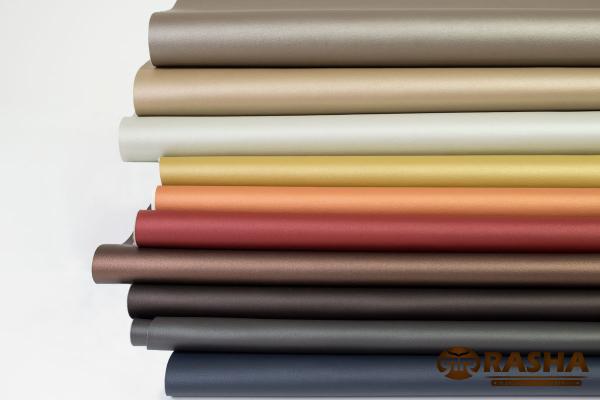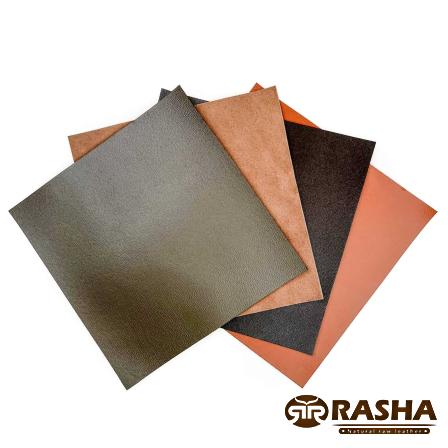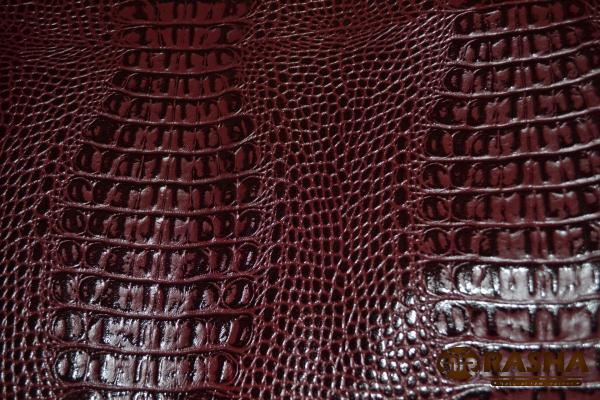In the world of fashion and interior design, leather has long been valued for its luxurious texture, durability, and timeless appeal. However, as the demand for animal-friendly and sustainable alternatives grows, synthetic leather has emerged as a viable option. In this article, we will delve into the characteristics, production processes, environmental impact, and overall pros and cons of both synthetic leather and genuine leather, enabling you to make an informed decision based on your preferences and values. Characteristics and Production: Leather, typically sourced from animal hides, is a natural material renowned for its unique qualities. It boasts a soft and supple texture, breathability, and develops a distinctive patina with age. Genuine leather comes in various types like full grain, top grain, corrected grain, and split leather, each with its own attributes and characteristics. On the other hand, synthetic leather, also known as faux or artificial leather, is made from various synthetic materials such as PVC (polyvinyl chloride) or PU (polyurethane). Synthetic leather attempts to mimic the appearance and feel of genuine leather while providing further versatility in terms of colors, patterns, and textures. Additionally, technological advancements have improved the quality of synthetic leather, making it hard to differentiate from the real thing. In terms of production, genuine leather involves treating animal hides through processes like tanning and dyeing, which require a significant amount of water, energy, and chemicals.

leather
 On the contrary, synthetic leather manufacturing entails the application of various chemical coatings onto fabric or polymer substrates, resulting in an easier and faster production process. Durability and Lifespan: Genuine leather is widely regarded for its durability and longevity. Properly cared for, leather products can last for decades, developing a beautiful patina that enhances its aesthetic appeal over time. It withstands wear and tear, stretching, and aging while retaining its quality and structure. Synthetic leather, on the other hand, generally has a shorter lifespan compared to genuine leather. It can be prone to cracking, peeling, and losing its original appearance over time, especially in high-stress areas. However, advancements in synthetic leather manufacturing techniques have led to improved durability, making it more resistant to wear and maintaining its original appearance for a longer period. Comfort and Breathability: One of the notable advantages of genuine leather is its exceptional breathability. It allows air to circulate, preventing the buildup of moisture and enhancing comfort. Leather has the ability to absorb and release moisture, ensuring a natural and comfortable feel under varying weather conditions. Despite the development of breathable synthetic leather, it still generally falls short in this aspect, often lacking in the ability to regulate temperature and moisture. Environmental Impact: When considering the environmental impact, it is essential to assess both the manufacturing processes and the materials used in leather and synthetic leather production. Genuine leather, particularly when sourced from animals like cattle, carries significant environmental implications. The meat and leather industry contribute to deforestation, water pollution, and greenhouse gas emissions. Additionally, the tanning process involves the use of toxic chemicals that can pose a risk to both human health and the environment. Synthetic leather can be perceived as a more environmentally friendly option because it does not directly involve animal exploitation. However, the production of synthetic materials like PVC and PU has its drawbacks. The production of PVC, for example, releases harmful chemicals and dioxins into the environment, while the production of PU requires non-renewable resources. Furthermore, the disposal of synthetic leather products also poses challenges due to their non-biodegradable nature. Ethics and Sustainability: For many individuals, the decision between synthetic and genuine leather extends beyond performance and material characteristics. Ethical considerations play a significant role in choosing between the two. Genuine leather, as a byproduct of the meat industry, raises questions regarding animal welfare. The demand for leather has led to unethical practices in some regions, such as illegal sourcing and poor treatment of animals.
On the contrary, synthetic leather manufacturing entails the application of various chemical coatings onto fabric or polymer substrates, resulting in an easier and faster production process. Durability and Lifespan: Genuine leather is widely regarded for its durability and longevity. Properly cared for, leather products can last for decades, developing a beautiful patina that enhances its aesthetic appeal over time. It withstands wear and tear, stretching, and aging while retaining its quality and structure. Synthetic leather, on the other hand, generally has a shorter lifespan compared to genuine leather. It can be prone to cracking, peeling, and losing its original appearance over time, especially in high-stress areas. However, advancements in synthetic leather manufacturing techniques have led to improved durability, making it more resistant to wear and maintaining its original appearance for a longer period. Comfort and Breathability: One of the notable advantages of genuine leather is its exceptional breathability. It allows air to circulate, preventing the buildup of moisture and enhancing comfort. Leather has the ability to absorb and release moisture, ensuring a natural and comfortable feel under varying weather conditions. Despite the development of breathable synthetic leather, it still generally falls short in this aspect, often lacking in the ability to regulate temperature and moisture. Environmental Impact: When considering the environmental impact, it is essential to assess both the manufacturing processes and the materials used in leather and synthetic leather production. Genuine leather, particularly when sourced from animals like cattle, carries significant environmental implications. The meat and leather industry contribute to deforestation, water pollution, and greenhouse gas emissions. Additionally, the tanning process involves the use of toxic chemicals that can pose a risk to both human health and the environment. Synthetic leather can be perceived as a more environmentally friendly option because it does not directly involve animal exploitation. However, the production of synthetic materials like PVC and PU has its drawbacks. The production of PVC, for example, releases harmful chemicals and dioxins into the environment, while the production of PU requires non-renewable resources. Furthermore, the disposal of synthetic leather products also poses challenges due to their non-biodegradable nature. Ethics and Sustainability: For many individuals, the decision between synthetic and genuine leather extends beyond performance and material characteristics. Ethical considerations play a significant role in choosing between the two. Genuine leather, as a byproduct of the meat industry, raises questions regarding animal welfare. The demand for leather has led to unethical practices in some regions, such as illegal sourcing and poor treatment of animals.
Specifications of leather
 Synthetic leather, while avoiding these concerns, still presents ethical dilemmas in terms of human labor and working conditions in the production of synthetic materials. Additionally, although synthetic leather reduces the demand for animal leather, it is not without its sustainability challenges, as mentioned previously. Cost: Cost is often a key factor when deciding between synthetic and genuine leather products. Genuine leather tends to be more expensive due to the additional craftsmanship and premium materials involved. However, prices can vary depending on the type and quality of leather used. Synthetic leather, being a manufactured product, is generally more affordable, making it a popular choice for fashion and interior designs on a budget. While affordable, it is important to consider the quality and durability, as cheaper synthetic leather may result in faster wear and tear, necessitating more frequent replacements. Conclusion: The choice between synthetic leather and genuine leather ultimately depends on individual preferences, priorities, and values. For those seeking a natural, luxurious, and durable material with a long lifespan and unique aging process, genuine leather remains the top choice. However, for individuals focused on animal rights, seeking versatility and affordability, and prioritizing the reduction of environmental impact, synthetic leather can be a viable alternative. As we continue to evolve and develop sustainable alternatives, it is crucial to make educated decisions that align with our values, ensuring that our choices contribute to a more ethical and environmentally conscious industry. Synthetic Leather vs Leather: A Comprehensive Comparison 1. Introduction – The growing demand for sustainable and animal-friendly alternatives to leather has led to the rise of synthetic leather. – This article provides a detailed comparison of synthetic leather and genuine leather, examining their characteristics, production processes, environmental impact, and overall pros and cons. 2. Characteristic and Production of Leather – Genuine leather is known for its soft and supple texture, breathability, and ability to develop a beautiful patina with age. – Leather, sourced from animal hides, comes in various types like full grain, top grain, corrected grain, and split leather, each with its own attributes. – Production processes for leather involve tanning and dyeing, which require significant amounts of water, energy, and chemicals. 3. Characteristic and Production of Synthetic Leather – Synthetic leather is made from synthetic materials such as PVC or PU, attempting to mimic the appearance and feel of genuine leather. – Technological advancements have improved the quality of synthetic leather, making it difficult to distinguish from the real thing. – Synthetic leather manufacturing involves the application of chemical coatings onto fabric or polymer substrates, resulting in a faster production process. 4. Durability and Lifespan – Genuine leather is highly durable and can last for decades with proper care.
Synthetic leather, while avoiding these concerns, still presents ethical dilemmas in terms of human labor and working conditions in the production of synthetic materials. Additionally, although synthetic leather reduces the demand for animal leather, it is not without its sustainability challenges, as mentioned previously. Cost: Cost is often a key factor when deciding between synthetic and genuine leather products. Genuine leather tends to be more expensive due to the additional craftsmanship and premium materials involved. However, prices can vary depending on the type and quality of leather used. Synthetic leather, being a manufactured product, is generally more affordable, making it a popular choice for fashion and interior designs on a budget. While affordable, it is important to consider the quality and durability, as cheaper synthetic leather may result in faster wear and tear, necessitating more frequent replacements. Conclusion: The choice between synthetic leather and genuine leather ultimately depends on individual preferences, priorities, and values. For those seeking a natural, luxurious, and durable material with a long lifespan and unique aging process, genuine leather remains the top choice. However, for individuals focused on animal rights, seeking versatility and affordability, and prioritizing the reduction of environmental impact, synthetic leather can be a viable alternative. As we continue to evolve and develop sustainable alternatives, it is crucial to make educated decisions that align with our values, ensuring that our choices contribute to a more ethical and environmentally conscious industry. Synthetic Leather vs Leather: A Comprehensive Comparison 1. Introduction – The growing demand for sustainable and animal-friendly alternatives to leather has led to the rise of synthetic leather. – This article provides a detailed comparison of synthetic leather and genuine leather, examining their characteristics, production processes, environmental impact, and overall pros and cons. 2. Characteristic and Production of Leather – Genuine leather is known for its soft and supple texture, breathability, and ability to develop a beautiful patina with age. – Leather, sourced from animal hides, comes in various types like full grain, top grain, corrected grain, and split leather, each with its own attributes. – Production processes for leather involve tanning and dyeing, which require significant amounts of water, energy, and chemicals. 3. Characteristic and Production of Synthetic Leather – Synthetic leather is made from synthetic materials such as PVC or PU, attempting to mimic the appearance and feel of genuine leather. – Technological advancements have improved the quality of synthetic leather, making it difficult to distinguish from the real thing. – Synthetic leather manufacturing involves the application of chemical coatings onto fabric or polymer substrates, resulting in a faster production process. 4. Durability and Lifespan – Genuine leather is highly durable and can last for decades with proper care.
buy leather
 – It is resistant to wear, tear, stretching, and aging while maintaining its quality and structure. – Synthetic leather generally has a shorter lifespan compared to genuine leather and may be prone to cracking and peeling over time. 5. Comfort and Breathability – Genuine leather excels in terms of breathability, allowing air to circulate and preventing the buildup of moisture. – Leather absorbs and releases moisture, ensuring a natural and comfortable feel under varying weather conditions. – Despite advancements, synthetic leather generally falls short in breathability, often lacking the ability to regulate temperature and moisture. 6. Environmental Impact: Genuine Leather – The leather industry, particularly the cattle industry, contributes to deforestation, water pollution, and greenhouse gas emissions. – The tanning process involves the use of toxic chemicals that pose risks to the environment and human health. 7. Environmental Impact: Synthetic Leather – Synthetic leather production reduces the demand for animal leather, but it is not without its environmental challenges. – The production of synthetic materials like PVC releases harmful chemicals and dioxins into the environment. – The production of PU requires non-renewable resources, and the disposal of synthetic leather products poses challenges due to their non-biodegradable nature. 8. Ethics and Sustainability: Genuine Leather – The demand for leather raises concerns about animal welfare, as it comes as a byproduct of the meat industry. – Unethical sourcing and poor treatment of animals have been reported in some regions. 9. Ethics and Sustainability: Synthetic Leather – Synthetic leather avoids animal exploitation concerns, but it raises ethical dilemmas regarding human labor and working conditions in the production of synthetic materials. – While reducing animal cruelty, synthetic leather is not without its sustainability challenges, as mentioned earlier. 10. Cost Considerations – Genuine leather tends to be more expensive due to craftsmanship and premium materials. – Price variations depend on the type and quality of leather used. – Synthetic leather is generally more affordable, making it appealing for budget-conscious consumers, but the quality and durability should be considered. 11. Consumer Preferences and Decision-making Factors – Consumer preferences for synthetic or genuine leather depend on factors such as desired characteristics, ethical considerations, sustainability concerns, and affordability. – Understanding the individual values and priorities is key to making an informed decision. 12. Conclusion – The choice between synthetic leather and genuine leather depends on personal preferences and values. – Genuine leather offers natural luxury, durability, aesthetics, and an aging process, but it raises concerns about animal welfare and environmental impact. – Synthetic leather provides versatility, affordability, reduced animal cruelty, yet it poses challenges in terms of sustainability and manufacturing processes. – Making an educated decision that aligns with personal values contributes to an ethical and environmentally conscious industry.
– It is resistant to wear, tear, stretching, and aging while maintaining its quality and structure. – Synthetic leather generally has a shorter lifespan compared to genuine leather and may be prone to cracking and peeling over time. 5. Comfort and Breathability – Genuine leather excels in terms of breathability, allowing air to circulate and preventing the buildup of moisture. – Leather absorbs and releases moisture, ensuring a natural and comfortable feel under varying weather conditions. – Despite advancements, synthetic leather generally falls short in breathability, often lacking the ability to regulate temperature and moisture. 6. Environmental Impact: Genuine Leather – The leather industry, particularly the cattle industry, contributes to deforestation, water pollution, and greenhouse gas emissions. – The tanning process involves the use of toxic chemicals that pose risks to the environment and human health. 7. Environmental Impact: Synthetic Leather – Synthetic leather production reduces the demand for animal leather, but it is not without its environmental challenges. – The production of synthetic materials like PVC releases harmful chemicals and dioxins into the environment. – The production of PU requires non-renewable resources, and the disposal of synthetic leather products poses challenges due to their non-biodegradable nature. 8. Ethics and Sustainability: Genuine Leather – The demand for leather raises concerns about animal welfare, as it comes as a byproduct of the meat industry. – Unethical sourcing and poor treatment of animals have been reported in some regions. 9. Ethics and Sustainability: Synthetic Leather – Synthetic leather avoids animal exploitation concerns, but it raises ethical dilemmas regarding human labor and working conditions in the production of synthetic materials. – While reducing animal cruelty, synthetic leather is not without its sustainability challenges, as mentioned earlier. 10. Cost Considerations – Genuine leather tends to be more expensive due to craftsmanship and premium materials. – Price variations depend on the type and quality of leather used. – Synthetic leather is generally more affordable, making it appealing for budget-conscious consumers, but the quality and durability should be considered. 11. Consumer Preferences and Decision-making Factors – Consumer preferences for synthetic or genuine leather depend on factors such as desired characteristics, ethical considerations, sustainability concerns, and affordability. – Understanding the individual values and priorities is key to making an informed decision. 12. Conclusion – The choice between synthetic leather and genuine leather depends on personal preferences and values. – Genuine leather offers natural luxury, durability, aesthetics, and an aging process, but it raises concerns about animal welfare and environmental impact. – Synthetic leather provides versatility, affordability, reduced animal cruelty, yet it poses challenges in terms of sustainability and manufacturing processes. – Making an educated decision that aligns with personal values contributes to an ethical and environmentally conscious industry.










Your comment submitted.